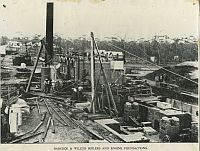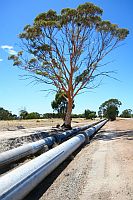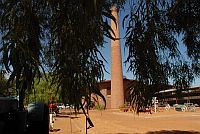History Of Cunderdin
The search for pastoral lands east of Perth led explorer Charles Hunt to many towns in today’s wheatbelt, including Cunderdin - a town he named in 1864. Derived from the Njungyar Aboriginal language it is said to mean ‘place of the bandicoot’ but according to another source translates as ‘place of many flowers’. The later is certainly true in the springtime when Cunderdin Hill – which overlooks the town - is carpeted with pink and yellow everlastings and yellow cascades of wattle.

Settlement in Cunderdin by Europeans started to progress following the building of the railway in 1884. Charles Hillman undertook the first farmlet in 1898 and by 1901 – thanks to the construction of the Goldfields Water Supply - more people ventured into the area. By 1902 Cunderdin boasted a small general store, a restaurant, hotel (also a receiving house for mail) and a school which was built by Charles Hillman.
In 1903 when the pipeline to Kalgoorlie was completed, the No 3 Pumping Station in Cunderdin was opened. This fine and imposing building, which housed the powerful steam engines responsible for sending the water down the line, still stands today and is home to the impressive Cunderdin Museum.
By 1906 Cunderdin was officially declared a townsite. There were 22 farms in the district – most of them spread south of the railway line from Youndegin - the earliest settlement in the area, some 19 kilometres away.
Thanks to an excellent rail service and an assured water supply (through the pipeline) the next three decades were periods of rapid development with farms expanding in every direction. Services in Cunderdin continued to expand and during the 1920s a Cottage Hospital – with resident doctor - was established.

The Cunderdin Airstrip was built early in the Second World War - designed as a bomber and RAAF flying school base. By 1941 the Elementary Flying Training School – as it was known – was at considerable strength with 34 officers, 500 airmen and 51 aircraft. Following the Second World War the No 9 Elementary Flying Training School was disbanded and the area was used as an Operational Base Unit, also disbanded in 1947. The school facilities were later used for a short time as a staging point for some 1000 displaced persons eventually sent on to Northam and other areas.
In 1945 the people of Cunderdin bought the local hotel making it the first community-owned hotel in Western Australia. Debentures were issued for the purchase price and investors received a fixed dividend with the balance being used for community and recreational projects.
In 1948 a new Junior High School was opened and an Agricultural wing was added later - taking over the facilities previously used by the Flying School. The wings’ modern buildings, expertly planned instructional facilities and delightful gardens made it quite a showpiece.
In 1950 the Road Board resumed 27 hectares of farmland bordering the townsite to develop a Greater Sportsground and Sporting Complex with first class facilities for many sporting activities. The building of the Memorial Swimming Pool in the mid 1950s set the standard for surrounding areas as it was the first rural swimming pool for many hundreds of kilometres.

During 1956 the No 3 Pumping Station upgraded to electric power. A workshop was started to carry out repair work for all the pumping facilities.
In 1968 the landmark community-owned Hotel venture ended quite suddenly when a disastrous earthquake struck in the nearby town of Meckering causing irreparable damage to the building. The property was subsequently sold to the Swan Brewery which built a modern, sophisticated hotel-motel on the original site. That hotel was later destroyed by fire in 2000 and replaced with the current Ettamogah Hotel.
Today, the town of Cunderdin is a thriving Wheatbelt community with a large range of services, business and sporting and community organisations. While agriculture still plays a major role in the town’s success, other industries are developing thanks to the town’s proximity to Perth and the size and quality of the Cunderdin Airstrip.